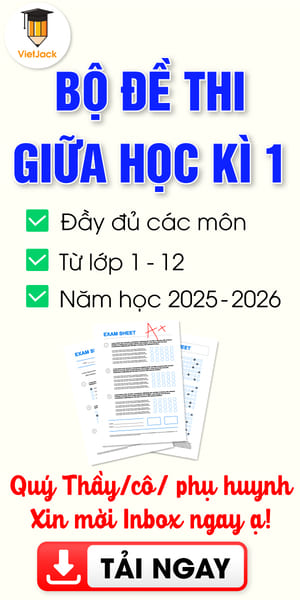Giáo án Tiếng Anh lớp 7 mới Học kì 2 chuẩn nhất
Với mục đích giúp các Thầy / Cô giảng dạy môn Tiếng Anh dễ dàng biên soạn Giáo án Tiếng Anh lớp 7, VietJack biên soạn Bộ Giáo án Tiếng Anh 7 mới Học kì 2 phương pháp mới theo hướng phát triển năng lực bám sát mẫu Giáo án môn Tiếng Anh chuẩn của Bộ Giáo dục. Hi vọng tài liệu Giáo án Tiếng Anh 7 này sẽ được Thầy/Cô đón nhận và đóng góp những ý kiến quí báu.
Giáo án Tiếng Anh 7 mới Học kì 2
Xem thử Giáo án Anh 7 Global success Xem thử Giáo án Anh 7 Friends Plus
Chỉ từ 250k mua trọn bộ Kế hoạch bài dạy (KHBD) hay Giáo án Tiếng Anh 7 Global success, Friends Plus chuẩn kiến thức, trình bày đẹp mắt, dễ dàng chỉnh sửa:
- B1: gửi phí vào tk:
1133836868- CT TNHH DAU TU VA DV GD VIETJACK - Ngân hàng MB (QR) - B2: Nhắn tin tới Zalo VietJack Official - nhấn vào đây để thông báo và nhận giáo án
- Giáo án Tiếng Anh 7 Unit 7: Traffic
- Giáo án Tiếng Anh 7 Unit 8: Films
- Giáo án Tiếng Anh 7 Unit 9: Festivals around the world
- Giáo án Tiếng Anh 7 Review 3
- Giáo án Tiếng Anh 7 Unit 10: Sources of energy
- Giáo án Tiếng Anh 7 Unit 11: Travelling in the future
- Giáo án Tiếng Anh 7 Unit 12: An overcrowded world
- Giáo án Tiếng Anh 7 Review 4
Giáo án Tiếng Anh 7 Unit 7: Traffic
Lesson 1/55: Getting Started
A. Aims and objectives.
1. Knowledge: By the end of the lesson, Ss will be able to use the lexical items related to the topic "Traffic", use "How............?" to ask about means of transport
2. Skills: Listening and speaking skills.
3. Attitude: Sts must have good attitude while working together.
4. Competencies: Talking about past habbits with "used to"
B. Preparation
- Teaching aids: Textbook, poster, tape and radio
C. Procedures
| LEARNING ACTIVITES | LANGUAGE FOCUS | ||||||||||||||
|---|---|---|---|---|---|---|---|---|---|---|---|---|---|---|---|
|
Warm up Matching (3 P7) - ? Run through all the words and phrases in 3 P7. ? Match a verb on the left with a mean of transport on the right. - There may be more than one correct answers. ? Read again in chorus. |
Key: 1. ride a bike 2. drive a car 3. fly a plane 4. sail on/in a boat 5. get on/ get off a bus/ a train/ a bike/ a motorbike.... |
||||||||||||||
|
I. Pre-listen and read 1. Vocabulary - Teacher use different techniques to teach vocab (situation, realia) - Follow the seven steps of teaching vocab. * Checking vocab: R.O.R 2. Choose a correct answer (1a P7) * Set the scene: ? Look at page 6 ? "Monday in the play ground in Viet ? Who are Oanh and Mai? ? What may they talk about? ? Run through the questions in 1a P7 ? Guess and choose a suitable answer before listening. ? Listen to the conversation once or twice then check your answer. - Teacher gets feedback |
- Repeat in chorus and individually - Copy all the words - Individual work - They are students. - They may talk about........ Key: 1B 2. A 3. B 4. C |
||||||||||||||
|
II. While - listen and read 1. Answer the questions (1b P7) - ? Read the conversation again then answer the questions in 1b P7 ? Work in pairs |
Key: 1. She played with her brother/ stayed at home. 2. It's about 2 kilometers. 3. She usually goes to school with her dad. 4. Because sometimes there are traffic jams. 5. She goes to school by bike. |
||||||||||||||
|
2. Colloquial expressions ? Refer back to the conversation and find the meaning of the colloquial expressions in 1c P7 ? Practice saying them together and give some examples ? Role-play the short conver. in 1d P7. ? Creat your short conversations. Use the colloquial expressions in 1c P7 ? Work in pairs |
1. Hey: to have someone's attention 2. Great idea: when you strongly support or agree with something 3. Can't wait: very excited and keen to do something. |
||||||||||||||
|
III. Practice. 1. Model sentences (Remember) - Elicit the question from students ? Practice asking and answering questions using "How"? Recall how to use a passive sentence. 2. Write the words (2 P7) ? Work in pairs. Write the means of transport under the right pictures. - Teacher monitors and gets feedback. 3. Find someone who never....(4 P7) - Teacher models ? Work in groups - Teacher monitors and gets feedback. |
- How do you come to school? = By what means do you come to school?? - How do you go to the supermarket? = By what means do you go to the supermarket? 1. bike/ bicycle 2. bus 3. plane 4. boat 5. ship 6. train 7. motorbike 8. car
A: Do you often walk to school? B: Yes, I do. A: Do you often walk to school? C (Nam): No. I never walk to school. |
||||||||||||||
|
IV. Consolidation ? Report find someone who never... ? Sum up the main content of the lesson. |
- Answer individually E.g: Nam never walks to school |
||||||||||||||
|
V. Homework - Learn by heart vocabulary and structures. |
- Listen and take note the assignments |
||||||||||||||
Lesson 2/56: A closer look 1
A. Aims and objectives.
1. Knowledge: By the end of the lesson, Ss will be able to:
- use the lexical items related to the topic "Traffic"
- know meaning of road signs
- pronounce sounds /e/ and /ei / correctly ion isolation and in context
2. Skills: Listening and speaking skills.
3. Attitude: Sts must have good attitude towards obeying the transportation rules.
4. Competencies: Talking about the meaning of the road signs
B. Preparation
- Teaching aids: Textbook, tape and radio
C. Procedures
| LEARNING ACTIVITES | LANGUAGE FOCUS | ||||||||||||||||||
|---|---|---|---|---|---|---|---|---|---|---|---|---|---|---|---|---|---|---|---|
|
I. Warm up Brainstorming ? Give all the road signs you see every day on the way to school ? Write as many words as possible ? Read again in chorus. |
Suggestion: - stop - no left turn/ no right turn - parking/ no parking - go ahead - no cycling - one-way ........ |
||||||||||||||||||
|
II. Vocabulary 1. Vocabulary - Teacher use different techniques to teach vocab (situation, realia) - Follow the seven steps of teaching vocab. * Checking vocab: Labeling (2 P8) ? Label the road signs in 1 with the words/ phrases in 2 ? Read all the phrases in chorus - Teacher explains the meaning if necessary. 2. Look out - Ask students to divide the road signs in 1 into three groups: informative, prohibitive, and warning base on their shapes and colours. - Teacher gets feedback and explains ? Give more examples |
- Repeat in chorus and individually - Copy all the words Key: 1. traffic lights 2. no parking 3. no right turn 4. hospital ahead 5. parking 6. cycle lane 7. school ahead 8. no cycling - A sign within a red triangle will warn you of something - Signs with red circles are mostly prohibitive - that means you can't not do something - Signs in blue are usually to give information |
||||||||||||||||||
|
3. Talk about the road signs (3 87) ? Work in pairs and talk about the road signs you see on the way to school (or elsewhere). - Teacher goes around and give assistance if necessary, and check their answers. |
E.g: A: On the way to school, I can see a "no left turn" sign. B: On my way to school there is a hospital, so I can see a "hospital ahead" sign. |
||||||||||||||||||
|
III. Pronunciation. 1. Sounds /e/ and /ei/ ? How to pronounce the sounds /e/ and /ei/? - Teacher models and give examples. - Ask students to observe teacher's mouth and listen carefully ? Practice the sounds together 2. Listen and repeat (4 P9) ? Listen to the recording 2 or 3 times ? Repeat in chorus ? Read individually. 3. Identify the sounds (5 P9)) - Play the recording 2 or 3 times ? Listen and distinguish the sound /e/ and /ei/. ? Recognize all the words with the two sounds, then underline them as assigned ? Work in groups and find words with the two sounds - Teacher monitors and gets feedback. |
- listen and repeat - pair work Key:
|
||||||||||||||||||
|
IV. Consolidation ? Sum up the main content of the lesson. |
- Answer individually - Remember |
||||||||||||||||||
|
V. Homework - Learn by heart vocabulary and structures. ? Do Ex A1,2 P3 (workbook) - Prepare: Unit 7: A closer look 2 |
- Listen and take note the assignments |
Giáo án Tiếng Anh 7 Unit 8: Films
Lesson 1/62: Getting started
A. Aims and objectives:
1. Knowledge: By the end of the lesson, Ss will be able to extend and practice vocabulary related to the topic “Films” through the dialogue between Duong and Mai about films.
2. Skills: Listening and reading.
3. Attitude: Sts must have good attitude towards watching films.
4. Competencies: Use language to ask and answer about films
B. Content:
- Vocab: vocabulary related to films
- Grammar: Suggestion, adverb clause with although.
- Materials: Ss’ books, text books, posters, tape and radio
D. Procedures:
| LEARNING ACTIVITES | LANGUAGE FOCUS | |||||||||||||||||||||||||||||||||
|---|---|---|---|---|---|---|---|---|---|---|---|---|---|---|---|---|---|---|---|---|---|---|---|---|---|---|---|---|---|---|---|---|---|---|
|
I. Warm up: Brainstorming - Elicit any information ss know about films by asking about types of film they know, the latest films they have seen , their favorite films and film stars - Use the pictures in textbook to introduce the new lesson |
||||||||||||||||||||||||||||||||||
|
II. The new lesson * Teaching new words - Teacher elicits the words from students. - Follow the seven steps of teching vocab. * Checking: What and where 1.Listen and read - T uses the pictures in the textbook to set the scene and asks some questions: Where are Phong and his sister Mai ? What are they talking about? - Ask ss to listen and read the conversation. - Play the recording twice - Ask ss to read the conversation aloud in pairs. a. Answer the questions - Ask ss to work individually to choose the correct answer to the questions. - Ask ss to read aloud the answers. - T confirms the correct answers b. Find the questions in the conversation that ask about Coconut Crazy - Run through the phrases - Ask ss to work in pairs to look at the conversation and find the questions. - Call on some pairs to read aloud and some ss to write on the board. - Ask ss to listen, check and repeat the questions 2. Matching the types of films with their definitions.. - Run through the phrases and sentences - Ask ss to work individually to match the types of films with their definitions. - Play the recording for ss to check their answers then ask them to repeat. - Correct their pronunciation if necessary - Help ss translate them into Vietnamese 3a. Think of a film. Fill in the blank - Have ss work dependently , filling in the table with the information of the films they have seen recently. Remind them to use the words and phrases they have learnt in 2 and from the conversation. b. In pairs, interview each other and try to guess the film - Ask ss to study the example. - T models with a good student. - Ask ss to work in pairs - Go around to help weak students - Call on some pairs to practise |
- Listen to teacher and answer questions - Practice the conversation in pairs - Work individually to choose the correct answer to the questions. * Answer key: 1-B 2-A 3-A 4-C 5-B - Work in pairs to find the questions. * Key: a. What kind of films is it? b. What does it stars? c. What is it about? d. What do critics say about it? - Listen and repeat the questions - Work individually to match the types of films with their definitions. Key: 1-d 5-b 2-f 6-e 3-a 7-h 4-c 8-g - Work dependently, filling in the table with the information of the films they have seen recently. - Possible answer: Mr. Bean Type of film: hilarious Actor: Rowan Atkinson Plot: Mr Bean's funny action Reviews: very funny and relaxed. - Work in pairs to interview |
|||||||||||||||||||||||||||||||||
|
III. Consolidation - Sum up the lesson IV. Homework - Learn by heart all the new words and structures. - Guide ss how to do Ex B1,2 - Prepare: A closer look 1 |
Answer - Take note |
Lesson 2/63: A closer look 1
A. Aims and objectives:
1. Knowledge: By the end of the lesson, Ss will be able to:
- use the lexical items related to the topic films
- pronounce correctly the -ed ending in verbs
2. Skills: Listening and reading.
3. Attitude: Sts must have good attitude towards watching films.
4. Competencies: Know how to use Ing- ADJ and Ed-ADj, know how to use the past simple tense
B. Preparation:
- Materials: Ss’ books, text books, posters, tape and radio
C. Procedures:
| LEARNING ACTIVITES | LANGUAGE FOCUS | ||||||||||||||||||||||||
|---|---|---|---|---|---|---|---|---|---|---|---|---|---|---|---|---|---|---|---|---|---|---|---|---|---|
|
I. Warm up - Ask ss to write the name of the film they like on a piece of paper and keep secret. - T call one student to stand in front of the class and ask him/her to give some clues . Others ask Yes- No questions to ask and guess the name of the film. |
Guessing Game |
||||||||||||||||||||||||
|
II.The new lesson Vocabulary T elicits Vocab from ss Check: RỎR Ask sts to copy down. |
|
||||||||||||||||||||||||
|
A. Vocabulary 1. Add some adjectives - Run through the adjectives that are often used to describe films. - Ask ss to work in pairs to add some more. Complete the sentences … - Ask ss to work independently to complete the sentences - Call on some ss to write the answers on the board. - Confirm the correct answers Remember - Ask ss to study the Remember box. Draw ss' attentionto the difference in use and meaning between -ed and -ing adjectives by analyzing the examples in the Remember box. Then ask ss to give examples. - Remind ss that they should use a good dictionary to check theit meaning and use 2.Complete the table with the -ed and -ing forms of the adjectives. - Ask ss to work individually to complete the table. - Let ss read aloud and some ss write on the board. - Translate each pair of adjectives to check ss' understanding - T confirms the correct answers 3. Choose the correct adjectives - Ask ss to do the exercise individually and check with the whole class. 4.a Work in pairs. Tell your partner how you felt, using -ed adjectives - Run through the questions - Ask ss to work in pairs to ask and answer. - Call on come pairs to practise. - Confirm the correct answer. |
Key: 1.hilarious 2. moving 3. boring 4. gripping 5. shocking 6. scary 7. violent 8. entertaining - Pay attention - We use -ed adjectives to describe someone's feelings and -ing adjectives to describe something or people (that cause the feelings) - Work individually to complete the table Key: 1. interested 2.embarrassing 3. exciting 4. disappointed 5. exhausted 6. surprising 7. confused 8 . frightening - Work individually to complete the table Key: 1. moving 2. frightening 3. disappointed 4. amazed 5. terrified Possible answers: Possible answers b. Use -ing adjectives to describe these things - Run through the questions - Ask ss to work in pairs to ask and answer. - Call on come pairs to practise. - Confirm the correct answers |
||||||||||||||||||||||||
|
B. Pronunciation /t/, /d/ and /id/ 5. Listen and repeat the verbs - T models the sounds/t/, /d/, and /id/ in different words with the ending-ed. 6. Ask and answer questions about the pictures - Let ss study the example, the pictures and cues |
/t/: after an unvoiced consonant( k, f, p, s, /ʃ/, /tʃ/) /d/: after a voiced vowel or voiced consonant /id/: after the sound /t/ and/d/ Key: /t/: watched, danced, walked /id/: waited, needed, hated /d/: played, bored, closed |
||||||||||||||||||||||||
|
III. Consolidation - Sum up the lesson - How to pronounce the sounds / d/./id/ and / t/ IV. Homework - Learn by heart all the new words and practice listening. - Guide ss how to do A1,2 /10 - Prepare: A closer look 2 |
- Answer - Take note |
Xem thử Giáo án Anh 7 Global success Xem thử Giáo án Anh 7 Friends Plus
Lời giải bài tập lớp 7 sách mới:
- Giải bài tập Lớp 7 Kết nối tri thức
- Giải bài tập Lớp 7 Chân trời sáng tạo
- Giải bài tập Lớp 7 Cánh diều
Tủ sách VIETJACK shopee lớp 6-8 (2025):
Đã có app VietJack trên điện thoại, giải bài tập SGK, SBT Soạn văn, Văn mẫu, Thi online, Bài giảng....miễn phí. Tải ngay ứng dụng trên Android và iOS.
Theo dõi chúng tôi miễn phí trên mạng xã hội facebook và youtube:Loạt bài Giáo án Sinh học lớp 7 mới, chuẩn nhất của chúng tôi được biên soạn bám sát nội dung sgk Sinh học 7 theo chuẩn Giáo án của Bộ GD & ĐT.
Nếu thấy hay, hãy động viên và chia sẻ nhé! Các bình luận không phù hợp với nội quy bình luận trang web sẽ bị cấm bình luận vĩnh viễn.
- Giáo án lớp 7 (các môn học)
- Giáo án điện tử lớp 7 (các môn học)
- Giáo án Toán 7
- Giáo án Ngữ văn 7
- Giáo án Tiếng Anh 7
- Giáo án Khoa học tự nhiên 7
- Giáo án Lịch Sử 7
- Giáo án Địa Lí 7
- Giáo án GDCD 7
- Giáo án Tin học 7
- Giáo án Công nghệ 7
- Giáo án HĐTN 7
- Giáo án Hoạt động trải nghiệm 7
- Giáo án Vật Lí 7
- Giáo án Sinh học 7
- Giáo án Hóa học 7
- Giáo án Âm nhạc 7
- Đề thi lớp 7 (các môn học)
- Đề thi Ngữ Văn 7 (có đáp án)
- Chuyên đề Tiếng Việt lớp 7
- Đề thi Toán 7 (có đáp án)
- Đề cương ôn tập Toán 7
- Đề thi Tiếng Anh 7 (có đáp án)
- Đề thi Khoa học tự nhiên 7 (có đáp án)
- Đề thi Lịch Sử & Địa Lí 7 (có đáp án)
- Đề thi Địa Lí 7 (có đáp án)
- Đề thi Lịch Sử 7 (có đáp án)
- Đề thi GDCD 7 (có đáp án)
- Đề thi Công nghệ 7 (có đáp án)
- Đề thi Tin học 7 (có đáp án)





 Giải bài tập SGK & SBT
Giải bài tập SGK & SBT
 Tài liệu giáo viên
Tài liệu giáo viên
 Sách
Sách
 Khóa học
Khóa học
 Thi online
Thi online
 Hỏi đáp
Hỏi đáp

